The X Button
Bullet Heaven
by Todd Ciolek,

Hey, want to read a review of Final Fantasy XIII? Well, I don't have one just yet. But I do have something equally important: a review of the game's case.
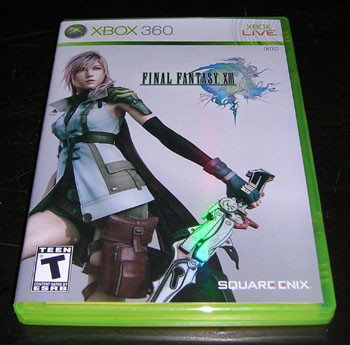
Here's Final Fantasy XIII for the Xbox 360. Its graphics aren't quite as sharp as the PlayStation 3 version's, but at least the packaging is the same. Or is it?
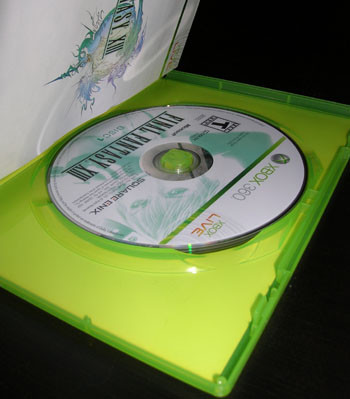
Yes, the Xbox 360 version of Final Fantasy XIII spans three DVDs, and Square Enix and Microsoft decided that, instead of using a case with three separate slots for the discs, they'd just stack them on one spindle.
This is a really minor annoyance, but it's an annoyance all the same. It looks like the game was packed up by a middle-school kid who couldn't find its real case. And while it may use less plastic, I'm quite baffled that Microsoft would hype Final Fantasy XIII, give the game its own system bundle, and then slap the DVDs into the case in the cheapest manner possible. At least they didn't stick one disc in a paper sleeve, which is what happened with Lost Odyssey.
Come back next week, when I'll complain about Final Fantasy XIII's title screen.
NEWS
PLAYSTATION MOVE CATCHES UP WITH MOTION-SENSING
 Nintendo has the Wii. Microsoft has Project Natal. And now Sony has its own motion-sensing controller. The PlayStation Move is very similar to the Wii remote: the main controller, topped by a glowing sphere, handles primary movement, and it's joined by a secondary controller. Yet the Move is also an evolution of Sony's Eye camera, and the two devices will work in concert.
Nintendo has the Wii. Microsoft has Project Natal. And now Sony has its own motion-sensing controller. The PlayStation Move is very similar to the Wii remote: the main controller, topped by a glowing sphere, handles primary movement, and it's joined by a secondary controller. Yet the Move is also an evolution of Sony's Eye camera, and the two devices will work in concert.
The first assortment of Move games is a basic showcase: EyePet is a virtual monkey-raiser, Move Party is a mini-game collection not far from Mario Party, Slider is a racer involving office chairs and other unorthodox vehicles careening through a city, Sports Champions is essentially Wii Sports Resort, TV Superstars is a game show simulator that uses the Eye, The Shoot is an old-fashioned arcade shooter, and Motion Fighter is, surprisingly enough, a simple fighting game.
Upcoming games such as SOCOM 4 will support the Move alongside traditional controls, and Sony is quick to point out that just about every major developer, including Square Enix and Konami, is working on a Move game or two. Several of those games may be available when the Move arrives this fall.
LAST STORY'S FIRST DETAILS EMERGE
Final Fantasy creator Hironobu Sakaguchi tried to dethrone Japan's biggest RPG names with his new Mistwalker label: Blue Dragon took a shot at Dragon Quest, Lost Odyssey gunned for Final Fantasy, and neither quite succeeded. It's too early to tell where Last Story, Sakaguchi's new Wii project, falls in the grand RPG subculture, but details of its setting recently emerged.
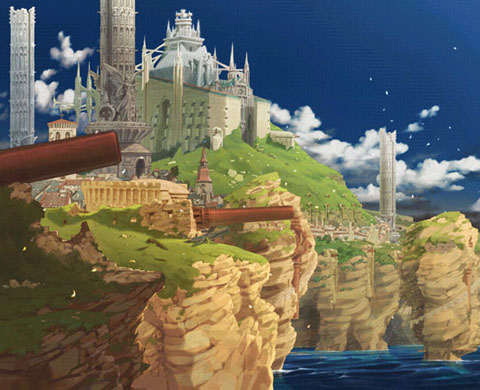
Last Story begins on Luli Island, a small sovereign nation besieged by invaders. The isle's ruler, Lord Aruganan, desperately hunts for some magical force to repel the enemies, and it just so happens that one town on the island is protected and made successful by an ancient magic. And then everything goes horribly wrong. Nothing more is yet known about the game or the characters, though the logo shows a young woman with a sword. The music's also nice, though fans are split on which popular RPG composer is actually working on the game. I suspect Hitoshi Sakimoto, because he's everywhere.
SOLAROBO IS REALLY JUST TAIL CONCERTO 2
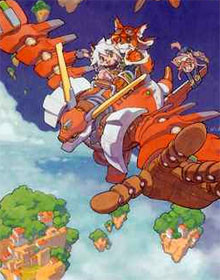 Tail Concerto, a 3-D adventure game for the ol' PlayStaiton, had rather awkward gameplay and a clichéd storyline. Yet it also had a carefree atmosphere and lots of endearing anime-animal characters, and the game gradually won its own cult of fans, not all of whom were desperate furries. For years, these fans begged developer CyberConnect 2 for a sequel. And now they're getting a DS sequel in everything but name.
Tail Concerto, a 3-D adventure game for the ol' PlayStaiton, had rather awkward gameplay and a clichéd storyline. Yet it also had a carefree atmosphere and lots of endearing anime-animal characters, and the game gradually won its own cult of fans, not all of whom were desperate furries. For years, these fans begged developer CyberConnect 2 for a sequel. And now they're getting a DS sequel in everything but name.
True, Solarobo doesn't feature any characters from the first Tail Concerto, but it has the same concepts: a world of floating islands, a Miyazaki-ish robot for players to control, and a cast of dog-people (or “Inubito”) and cat-people (“Nekobito”) to fill all of the standard anime-fantasy archetypes. In fact, Solarobo even seems to be the same kind of story, with a teenage dog swordsman named Red Savarin meeting a suspicious catgirl named Ell Melizee.
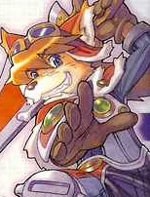 Solarobo also brings back a lot of the Tail Concerto staff, with Takayuki Isobe once again directing and illustrator Nobuteru Yuuki designing the world and the characters. The mecha come from Yoshitake Taniguchi of Super Robot Wars, and the animated introduction will be handled by Madhouse.
Solarobo also brings back a lot of the Tail Concerto staff, with Takayuki Isobe once again directing and illustrator Nobuteru Yuuki designing the world and the characters. The mecha come from Yoshitake Taniguchi of Super Robot Wars, and the animated introduction will be handled by Madhouse.
Solarobo also tries to build on Tail Concerto's groundwork, with 3-D levels in which Red's robot, the Dahak-AZ103, throws crates, catches missiles, and bashes enemies. The Dahak can also gain experience and new modifications, and there's even an online multiplayer mode. Solarobo would also need to improve Tail Concerto's controls and object detection, but I suspect that CyberConnect 2 learned a few things from making .hack games and Naruto fighters over the years. Now all they have to do is announce a Silent Bomber sequel to shut up the other half of their fan base.
RONDO OF BLOOD HITS WII'S VIRTUAL CONSOLE
The Wii's Virtual Console isn't making the news too often. It's seeing fewer and fewer releases of older games, and Nintendo's WiiWare service is overshadowing it. Yet there are still some excellent titles lurking over on the Japanese Virtual Console, and now we're getting one more in North America. Rondo of Blood, the best of the old-school Castlevania games, is now available to us all.
Unfortunately, the game isn't translated, so you'll have to make do with the Japanese dialogue (and the German voice-overs in the opening), just as Americans did when Rondo hit the Japanese PC Engine back in 1993. It's strange that Konami didn't localize the Virtual Console release, since a fully dubbed and translated version of the game was included with Castlevania: The Dracula X Chronicles on the PSP.
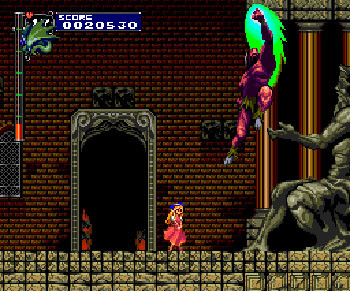
That aside, Rondo of Blood is still the spectacular action game it's always been, and the emulation's more accurate on the Virtual Console than it was on the PSP. I find most of the old-fashioned Castlevanias really boring, but Rondo is much better, with an accomplished gothic atmosphere, excellent bosses, and all sorts of secrets. The biggest extra is a second playable character, Maria Renard, who's basically the most powerful Castlevania lead ever. Considering how Castlevania's heroes were mostly gruff, whip-cracking manly men up to this point in history, it's amusing that Rondo lets a little girl in a pink dress steamroll hideous monsters by throwing birds at them. And that's why Rondo is worth owning in any form.
REVIEW: ESPGALUDA II
 Developer: Cave
Developer: Cave
Publisher: Cave
Platform: Xbox 360 (import)
Players: 1-2
MSRP: Roughly $70 (regular edition) or $150 (limited edition)
Note: The regular edition is region-free. The limited edition is region-locked for Japanese systems.
Modern shooters follow two paths. There are the patiently challenging likes of Gradius and R-Type, where bullets fly precisely at the player and surviving each stage is a matter of memorizing it. Then there are the manic displays of “bullet hell” shooters, where enemies blanket the screen with brightly colored shots, and woe to the player who can't weave through the few tiny safe spaces. Cave traffics mostly in bullet hell, usually adding some power-up system that gives players a fighting chance against insanely massive volleys of enemy fire. The ESP series of vertical shooters finds Cave at their best in mixing thoughtful design and hectic bullet-dodging, and ESPgaluda II takes the whole idea to wonderful places.
Make no mistake: ESPgaluda II is a bullet-hell shooter to the core. Upon choosing a winged hero or heroine, players rush through the skies of a medieval-fantasy kingdom, tearing through ornate bronze tanks and jointed dragon-mecha and sculpted gunboats. And all of them fire lots and lots of bullets your way. There's rarely a moment in ESPgaluda II where glowing blue or red bullets aren't erupting from every possible enemy on the screen.
To deal with these constant threats on their lives, the four playable fairy-winged characters invoke several counterattacks. In addition to putting up a limited-time shield, they fire wide-angle regular shots and, when the button is held down, focused laser-like "rapier" attacks. Asagi auto-targets some enemies, Ageha waves bullets around, and Tateha fires through enemies. Each of them also uses a Kakusei mode, perhaps the game's most interesting point. Invoked by tapping a button, Kakusei turns every bullet pink and slow, allowing players to navigate the gunfire more easily and boost their scores. It also makes Tateha, Ageha, and Asagi switch genders, which I'm sure is part of ESPgaluda II's bizarre backstory.
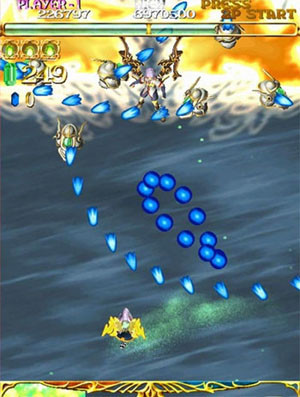
Kakusei mode may not sound particularly novel, since deliberate slowdown has been a staple of games for decades. Yet it separates ESPgaluda II from many other bullet-hell shooters, most of which are content to simply throw waves of shots at the players, who will be too busy dodging to notice bland game design. ESPgaluda II's Kakusei puts that dodging art under the player's control, letting them navigate thick seas of enemy fire with ease. Destroying enemies in this mode has the added effect of turning their mid-air bullets into score-boosting money. Of course, it doesn't last: Kakusei mode depletes the number of green gems in the player's possession, and when the counter reaches zero, all of the bullets turn red and actually move faster. That's your cue to shut off Kakusei and earn more gems by blowing up enemies.
It also helps that ESPgaluda II is designed well enough to make Kakusei rewarding. While not as varied as, say, a Treasure shooter, the opposition in ESPgaluda II keeps up a constant challenge. The bullet storms are ferocious in both quantity and placement, putting players constantly on edge and leaving them wondering just how they'll survive the next rain of cannon fire. Yet they will survive, once they learn to be quick enough and judicious in their use of Kakusei's bullet-slowing powers.
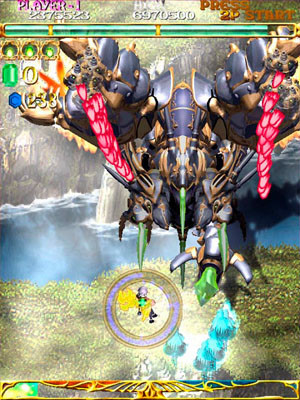
For a shooter made in 2005, ESPgaluda II looks quite good in its upscaled XBox 360 mode. It's brightly colored and filled with an interesting aesthetic of neon-winged pixies shredding the military forces of a steampunk Ottoman Empire. It's almost a shame that the game's pretty scenery is rarely visible behind the curtains of pastel-blue bullets. The soundtrack (included with first pressings of the game) is catchy enough, and there's plenty of voice acting from the characters. There is indeed some sort of story to all of this, though only the endings explore it. Any plot apparently exists to make you feel a tinge of pity for the bosses, some of whom are merely despondent children.
There is, however, the question of how much of a game you're getting for the import price. ESPgaluda II, like most arcade shooters, is rather short, clocking in at about 45 minutes. In the arcade, this isn't so much of a problem, as the typical shooter kills players frequently and demands more money. When ported to a home console, however, a shooter can't very well charge the player for each credit. A lot of shooter developers ignore this and make no effort to adjust their continue systems, and Cave is among them. ESPgaluda II allows unlimited continues in its main modes, and players can simply credit-feed through the game no matter how many times they die.
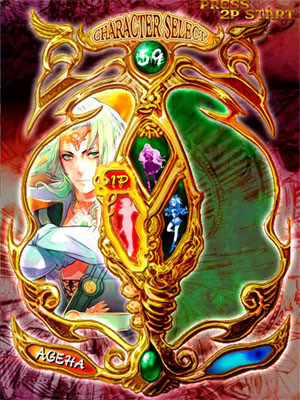
Some shooter fans refuse to admit that this is flawed design. They claim that shooters like ESPgaluda II are meant to be played and mastered to the point where you can finish them on one credit. These people are all insane. If players must rely on self-imposed challenges to make a game interesting, there's something wrong, and good designers don't let players walk all over their creations. Treasure, for example, used an excellent continue system in Radiant Silvergun and Ikaruga; the games offered three or four continues at the start, with each hour of playtime unlocking another continue. Unlimited credits were only given by the ten-hour mark, by which point most players had already made it through the game. It's an ingenious system, and there's no excuse for shooter developers like Cave not putting something similar in their ports.
While Cave can be faulted for not making ESPgaluda II Black Label legitimately hard, they didn't skimp on the extras. In addition to the regular arcade game, there's an Xbox 360 revamp with sharper graphics, an introductory “Novice” mode, a strange “Omake” mode, and two other different takes on the game. Black Label mode replaces Asagi with a recurring ESPgaluda boss named Seseri, and her shots grow stronger when she's close to enemy fire. Arrange mode, crafted by Shinobu Yagawa (Battle Garegga, Dimahoo), turns the game into a fast-paced puzzle like Treasure's Ikaruga, as enemies fire red and blue bullets. The red ones are canceled by regular player shots, while the blue ones must be taken down with lasers. Of course, it would be even better if this package also featured the original ESPra.de. , which never saw a home port. I suspect the rights to that one are split between Cave and Atlus.
The variety of modes adds a lot to the game, and ESPgaluda II is the rare shooter that's built well enough to encourage return trips. Even if you spam continues on your first run through, it's well worth revisiting the game to master the Kakusei bullet-dodging, to boost your score, or to simply revel in that basic shooter joy of weaving through chaos and destroying everything before you. ESPgaluda II delivers that exceptionally well, and it's essential for anyone who's ever properly appreciated a good shooter.
RELEASES FOR THE WEEK OF 3-21
BAKUGAN BATTLE TRAINER Developer: Some Poor Suckers
Developer: Some Poor SuckersPublisher: Activision Platform: Nintendo DS Players: 1 MSRP: $29.99 I mocked Bakugan Battle Brawlers the last time I mentioned it here, but the truth is that, as a former chronicler of the anime industry, I'm happy for Bakugan's success. In a market where DVD sets of awful cartoons like Camp Candy and Stunt Dawgs would sell better than the typical anime release, it's comforting to see one recent anime property eating up shelves in Target. Battle Trainer is a somewhat simplified version of the Battle Brawlers concept, as it removes the part of combat that involves Bakugan landing on a card or something. The emphasis is on preparing Bakugan creatures for duels, and the training regimen involves rolling them around a playfield, moving them through a maze, or playing one of several other mini-games. It's all part of some plot involving a Bakugan-based war against alien usurpers, which furthers the vast epic that is Bakugan Battle Brawlers. And there I go again, making fun of anime's most recent big thing.
|
RED STEEL 2 Developer: UbiSoft Paris
Developer: UbiSoft ParisPublisher: UbiSoft Platform: Nintendo Wii Players: 1 MSRP: $49.99/$59.99 (Wii Motion Plus Bundle) The original Red Steel benefited greatly from being a violent action game during the Wii's launch, when new owners of the system were desperate for something that didn't involve smiling Mii avatars playing tennis. Red Steel was also a bit awkward and repetitive, but Ubisoft seems to fix a few things in Red Steel 2. It's forgoing the original game's modern Yakuza war in favor of a weird samurai-Western stage not that far from Rising Zan. Focusing on a vengeful warrior known only as The Swordsman, the gameplay gives our unnamed hero all sorts of moves involving firearms and bladed weapons. His frequently expanding repertoire even mixes the two, as he can block bullets with his katana blade, just as real samurai do in real life all the time. Ubisoft also promises much more accurate controls, and the game's even bundled with a Wii Motion Plus adaptor to show just how it's improved. It's also a bit more cartoon-like and less bloody than the first, but that might be another improvement.
|
SHIN MEGAMI TENSEI: STRANGE JOURNEY Developer: Atlus
Developer: Atlus Publisher: Atlus Platform: Nintendo DS Players: 1 MSRP: $34.99 In a way, most of the Shin Megami Tensei games are dungeon-crawlers. Even when emphasizing high-school romance or post-apocalyptic crime, the series rarely neglects the art of hacking through a monster-infested labyrinth. In Strange Journey, those labyrinths lie just beyond a bizarre dimensional rift in the skies above Antarctica. The player names the lead character, who joins three other researchers on an expedition through the rift. They find a strange land of unsettling architecture, ready to be mapped out and thoroughly explored. While the party starts off with four humans in Demonica environmental suits (which look like the Cybermen from Doctor Who), many of the creatures encountered can be turned into allies. In fact, the monsters can even combine their abilities to produce new attacks, even if that's not a polite thing to do to the first new friends you make in a harsh alien dimension.
|
EXTRA LIVES: DRAGON BALL Z V.R.V.S.
 Dragon Ball Z V.R.V.S. went against the grain back in 1994. Approximately 11 billion different Dragon Ball Z fighting games were made around that time, but most of them were conventional in their approaches, turning Dragon Ball Z battles into aerial versions of Street Fighter II. But Sega wasn't having any of that in its Dragon Ball Z fighter. After all, it was an arcade game, and an arcade game needed some novel new interface to pull kids away from Street Fighter II and all of the games that wanted to be Street Fighter II. And so V.R.V.S. took shape. Partly.
Dragon Ball Z V.R.V.S. went against the grain back in 1994. Approximately 11 billion different Dragon Ball Z fighting games were made around that time, but most of them were conventional in their approaches, turning Dragon Ball Z battles into aerial versions of Street Fighter II. But Sega wasn't having any of that in its Dragon Ball Z fighter. After all, it was an arcade game, and an arcade game needed some novel new interface to pull kids away from Street Fighter II and all of the games that wanted to be Street Fighter II. And so V.R.V.S. took shape. Partly.
In a strange move, Dragon Ball Z V.R.V.S. takes more from Punch-Out! and other boxing games than the likes of Fatal Fury and Street Fighter. Instead of showing its battle from the side, V.R.V.S. puts the player's perspective behind the character. The other half of the screen is filled by the opponent's view, while the background rolls beneath the two airborne fighters. The combatants can dodge, dash, charge moves, block with huge black spherical shields, and hurl either close-up punches or long-range projectiles. The cast is rather small for a Dragon Ball Z game, however, as players get to choose from Goku (written here as “Son Go Kuh”), Gohan, Vegeta, Trunks, and Piccoro, who I am told is actually called “Piccolo.”
 It's a decent idea for a fighter, and yet the game often degenerates into a repetitive mess, much like the 16-bit Bastard!! aerial brawler. The attacks are limited, dodging is harder than it needs to be, and the battles all but ask you to pull off the same moves over and over. The half-screen given to each player doesn't allow for a decent view of the playing area, and evasive action really can't help in combat. The game is also loaded with an epileptic's nightmare of flashing effects, with huge kanji advice that often scrolls across the screen, obscuring the view of one's opponent.
It's a decent idea for a fighter, and yet the game often degenerates into a repetitive mess, much like the 16-bit Bastard!! aerial brawler. The attacks are limited, dodging is harder than it needs to be, and the battles all but ask you to pull off the same moves over and over. The half-screen given to each player doesn't allow for a decent view of the playing area, and evasive action really can't help in combat. The game is also loaded with an epileptic's nightmare of flashing effects, with huge kanji advice that often scrolls across the screen, obscuring the view of one's opponent.
There's a reason for this simplicity. Most Dragon Ball Z V.R.V.S. arcade machines used a standard-issue joystick and three buttons, but the game was also designed for a motion-sensor that tracked the player's gestures. That may sound like the precursor to the Wii, but I suspect the results were a lot like the U-Force, the Activator, and other 1990s controllers that lied to kids about motion-sensing.
 Dragon Ball Z V.R.V.S. isn't particularly notable for fans, though the characters are large and well-rendered, with plenty of sound samples from the show's voice actors. Yet the game's visual style seems half-hearted, and the flashing text gives it the feel of some knock-off Dragall BarZ game found in some Hong Kong basement arcade. The sole point of interest might be the game's boss, Ozotto. He's a shapeshifter whose true form was stitched together from other Dragon Ball Z villains, and Dragon Ball Z V.R.V.S. is the only place he's ever appeared.
Dragon Ball Z V.R.V.S. isn't particularly notable for fans, though the characters are large and well-rendered, with plenty of sound samples from the show's voice actors. Yet the game's visual style seems half-hearted, and the flashing text gives it the feel of some knock-off Dragall BarZ game found in some Hong Kong basement arcade. The sole point of interest might be the game's boss, Ozotto. He's a shapeshifter whose true form was stitched together from other Dragon Ball Z villains, and Dragon Ball Z V.R.V.S. is the only place he's ever appeared.
Perhaps Dragon Ball Z V.R.V.S. was ahead of its time. A motion-sensing Dragon Ball Z fighter was too much trouble for the arcades of 1994, when vendors could put in another Street Fighter II clone and make just as much money. But arcades hit hard times around 2000, and that's when kids in both Japan and North America might've flocked to a Dragon Ball Z fighter that read their crazed air-punches. But it's too late for that now, isn't it?
Dragon Ball Z V.R.V.S. is relatively rare as arcade boards go, since it was never released outside of Japan. The motion-sensing version of the game is even harder to come by. At the very least, it would make for an interesting conversation piece.
discuss this in the forum (36 posts) |
this article has been modified since it was originally posted; see change history